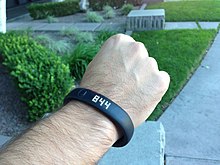
Quantified self is both the cultural phenomenon of self-tracking with technology and a community of users and makers of self-tracking tools who share an interest in "self-knowledge through numbers".[1] Quantified self practices overlap with the practice of lifelogging and other trends that incorporate technology and data acquisition into daily life, often with the goal of improving physical, mental, and emotional performance. The widespread adoption in recent years of wearable fitness and sleep trackers such as the Fitbit or the Apple Watch,[2] combined with the increased presence of Internet of things in healthcare and in exercise equipment, have made self-tracking accessible to a large segment of the population.
Other terms for using self-tracking data to improve daily functioning[3] are auto-analytics, body hacking, self-quantifying, self-surveillance, sousveillance (recording of personal activity), and personal informatics.[4][5][6]
- ^ Ferriss, Tim (2013-04-03). "The First-Ever Quantified Self Notes (Plus: LSD as Cognitive Enhancer?)". The Blog of Author Tim Ferriss. Retrieved 2019-04-18.
- ^ Lamkin, Paul (22 February 2018). "Smartwatch Popularity Booms With Fitness Trackers On The Slide". Forbes.
- ^ Dorminey, Bruce (2012-05-31). "Tic-Toc-Trac: New Watch Gadget Measures Time Perception For The Self-Quantifying". Forbes.
- ^ Wilson, H. James (September 2012). "You, By the Numbers". Harvard Business Review. Retrieved 2015-08-18.
- ^ Hill, Kashmir (April 7, 2011). "Adventures in Self-Surveillance, aka The Quantified Self, aka Extreme Navel-Gazing". Forbes.
- ^ "Counting every moment". The Economist. March 3, 2012.